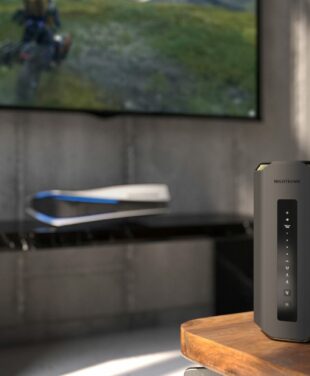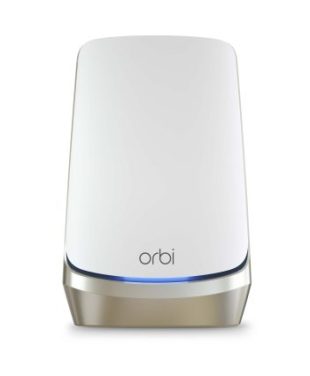Mesh WiFi satellites spread your WiFi signal far and wide, and the right mesh WiFi setup ensures you won't find yourself in a dreaded WiFi dead zone while you're trying to stream your favourite show or conquer that final level in your game. Let’s explore mesh satellite wireless networks.
IN THIS ARTICLE
Understanding Mesh WiFi Satellites
Is your internet WiFi coverage struggling to keep up with device demands? Are you getting ready to upgrade your WiFi setup? A mesh WiFi system will improve internet speeds, eliminate WiFi dead spots, and extend coverage across your home with the addition of router satellite nodes. However, every household is different, and the design and layout of the home can also affect home mesh WiFi performance. On this page, we explore the home and office networking potential of some of the best WiFi router mesh products on the market.
Do You Need Mesh WiFi?
In a mesh WiFi setup, satellite nodes communicate with each other and with your main access point router to extend network coverage. Mesh WiFi technology eliminates dead zones and can dramatically improve WiFi speeds and system performance. An investment in mesh WiFi, particularly the latest WiFi 7 systems, will future-proof your home network, office network, guest network, and smart home network for many years to come.
If yours is a small dwelling or unit, a traditional router may be enough to provide adequate WiFi coverage for the square feet of your home. Ethernet cable connections and a WiFi extender are also workable options for smaller households with only one or two people and a few connected devices. On the other hand, technology is moving fast and changing the way we live, work, and play. An average home in Australia today can include 20+ connected devices and smart home appliances, with many running concurrently 24/7.
Modern large homes and offices with multi-levels or complex layouts will benefit from the introduction of whole-home mesh WiFi systems such as NETGEAR Orbi 970. Mesh router satellite antennas relay the signal from your main router, without diminished WiFi performance. In other words, everyone under one roof can enjoy their own WiFi space for high-definition streaming, competitive gaming, downloading large files, and completing important work and school projects hassle-free and on time. The future is now with NETGEAR Orbi WiFi 7.
Factors Influencing the Number of Satellites Needed
Your home is unique, and so are your WiFi network needs. The number of satellites you need depends on a few key things:
• Home Size: Bigger homes generally need more satellites.
• Layout and Design: Open-plan homes might get away with fewer satellites, while multiple rooms and floors might need more.
• Building Materials: Thick walls and metal structures can be tough for WiFi signals to penetrate.
Every home is different, making it difficult for homeowners to estimate how many mesh satellites are required for optimal WiFi coverage. Mesh satellite square footage reach provides an estimate, but the design of your home, the building materials used, and built-in home features will all impact WiFi performance. For example, WiFi signals are diminished when they travel through brick walls or other solid objects. Having said that, it’s still helpful to estimate potential square feet of satellite node WiFi coverage to put you in the picture before you purchase a new system. Here are some guidelines.
• One router and one satellite – up to 440 sq. m
• One router and two satellites up to 660 sq. m.
• One router and three satellites up to 880 sq. m.
• One router and four satellites, or more – over 1000 sq. m.
Keep in mind that these are estimates only. Those who live in multi-story or expansive homes may need extra mesh WiFi nodes for a fast and stable internet connection. In addition, if your modem and main access point WiFi router are situated at one end of your home, you may need more WiFi satellites for whole-home coverage. You can always add more satellite nodes at a later date to create seamless internet access across your entire home or office space.
Where to Place Mesh WiFi Satellites
Wireless router mesh satellite placement depends on the shape, size, and makeup of your home. As a general rule, you should place each WiFi satellite node approximately halfway between another node or your main router and the dead zone space you are trying to improve with better WiFi coverage. You will need to place your nodes near power points so they can be powered up.
Mesh nodes work best when they are placed in an open area with a direct line of sight to other nodes, your main router, and your connected devices. The best WiFi 6, WiFi 6E, and WiFi 7 mesh systems today include Ethernet LAN ports on every satellite, so you can directly plug in specific data-hungry devices such as gaming consoles, virtual reality tech, and high-performance Apple Mac and Windows systems. Although WiFi is the way of the future, Ethernet cables and Ethernet adapters remain a valuable addition to any local area network (LAN) system.
You may need to experiment with satellite node placement to get the best possible results. For example, higher satellite placement can offer a clearer signal path and also reach devices upstairs. However, if you want WiFi in the basement or garage, you will probably need a dedicated satellite node for that space.
NETGEAR Orbi and NETGEAR Nighthawk products include mesh network apps that can be downloaded on your smartphone. Download the app for assistance with the setup, including signal strength and other WiFi analytics. The entire system can be up and running within half an hour, and if you are renting your home, you can take the WiFi mesh system with you when you move.
Installation Tips for Optimal Coverage
When setting up satellites for a tri-band WiFi or quad-band WiFi connection, strategic placement is key. With Orbi, you’ll find the setup process is a breeze, thanks to its user-friendly design. Often, one Orbi unit per 4-5 rooms can be sufficient. Once set up, the system is easy to manage. A blue LED status light indicates that your satellite node is within range of the Orbi router. You can add as many satellites as needed for your space. Here are some key points to consider.
Space Size – Perform a rough measurement of the square footage of your home or office. A large space will require more satellites to ensure comprehensive nest WiFi coverage.
Coverage Goals – Aim for seamless coverage throughout the entire space or target specific areas for improving the WiFi signal.
Signal Strength – Identify zones where the signal is weak. These are the areas you should focus on for improving your internet connection.
Building Layout – Consider architectural elements like walls and floors that will impact the WiFi signal penetration. Thick walls or multiple floors might necessitate additional satellites.
Device Density – Estimate the number of devices you want to connect to the network. Orbi 970 mesh WiFi 7, for example, can handle over 200 connected devices simultaneously.
Bandwidth Requirements – Determine the intensity of data usage for activities like streaming and gaming that demand higher bandwidth.
Tri-Band and Quad-Band Satellites – Unlike dual-band WiFi, tri-band and quad-band satellites use a dedicated backhaul channel that enhances communication between satellites.
Future Expansion – Think about potential changes as your network evolves. Easily accommodate growth by introducing extra satellites without suffering compatibility issues.
Orbi Satellite Specifications – Each Orbi satellite model has specific coverage capacities. Check the specifications of your chosen model.
Mesh Topology – Plan the positioning of satellites to create an effective overlapping mesh network. Proper satellite placement enhances coverage and minimises interference.
Performance Expectations – Define the WiFi signal performance you expect in each area. High-performance zones might require closer satellite placement.
The NETGEAR Orbi Advantage
NETGEAR Orbi whole-home mesh WiFi systems are known for their robust coverage, with fewer satellites required compared to other systems. In addition, Orbi satellite nodes are attractive decor pieces. Orbi’s powerful performance can efficiently cover large areas, making it a top pick for many homes. Strategically placed Orbi satellites let you roam seamlessly and experience true gigabit connection speeds with a compatible broadband internet connection.
This Orbi 970 system can connect 200+ devices and smart home applications such as Amazon Alexa, security cameras, and smart TVs. Orbi delivers faster download speeds, high throughput, multi-link operation, and low latency. Orbi instantly transfers data, without lag, between the main router and satellites. The main Orbi router access point has a 10 Gbps Ethernet port, four 2.5 Gbps Ethernet ports, and a 10 Gig Internet port. Orbi 970 satellites contain a 10Gbps Ethernet port and two 2.5 Gbps Ethernet ports.
Determining Your Needs with NETGEAR Orbi
Choosing between a traditional router, range extenders, or Orbi satellites is straightforward. For average-sized homes, a two or three-satellite setup is often enough to provide blazing-fast internet. Orbi Mesh Systems are preconfigured for easy setup and optimal WiFi performance, and additional Satellites can be used to extend the range of an Orbi Mesh System. Make sure to choose add-on satellites that are compatible with your Orbi Router.
The first two digits of the model number on Orbi routers or Orbi kits indicate the series number. For example, the WiFi 6 mesh system, Orbi RBKE963 from the Orbi 960 Series, is designed to work with 960 Series add-on Satellites. You can also check your router series number on the bottom of the unit. Here are some great NETGEAR Orbi systems worth considering.
Orbi 970 Series Quad-Band WiFi 7 Satellite Add up to 220 sq. m.
Compatible with Orbi 970 series
Discover lightning-fast, lag-free internet for all your connected devices with the latest WiFi 7 Orbi satellite technology.
Features include:
✔ Blazing fast Quad-Band WiFi 7 up to 27Gbps
✔ Enhanced Dedicated Backhaul with 5Ghz and 6Ghz bandwidths
✔ Extend whole-home Orbi Coverage up to 220 Sq. Ft.
✔ 10-Gig LAN ports (10/100/1000Mbps) providing high-speed wired connections or Optional 10Gig wired Ethernet backhaul
✔ 2x 2.5Gb Ethernet Ports for high-speed wired connections
✔ Available in classy white and classic black to fit any décor style
✔ Requires Orbi Router (RBE971S) sold separately
Orbi 960 Series Quad-Band WiFi 6E Satellite Add up to 200 sq. m.
Compatible with Orbi 960 series
Experience the first quad-band WiFi 6E add-on Orbi Satellite, and enjoy low-latency, superfast internet across your entire local area network (LAN) or wide area network (WAN).
Features include:
✔ Connection speeds of up to 10.8Gbps
✔ Dedicated 5Ghz WiFi backhaul
✔ 2.5Gb Ethernet LAN port for wired devices or optional wired Ethernet backhaul
✔ 3x 1Gb Ethernet LAN ports (10/100/1000Mbps) for streaming devices, game consoles, computers, and more
✔ Available in classy white and classic black to fit any décor style
✔ Requires Orbi Router (RBRE960 or RBRE960B) Sold Separately
FAQs
Can I add more satellites to my network later?
Absolutely! One of the attractive features of Mesh WiFi systems is their scalability. You can start small and expand as needed.
How do obstacles like walls affect the number of satellites I need?
Thick walls made from dense brick or stone can impede WiFi signals. You might need additional satellites to ensure strong coverage throughout your network.
Are there different needs for single-story vs multi-story homes?
Multi-story homes often require more satellites to ensure each floor receives a strong signal. Experiment with your mesh layout and add more satellite nodes as required.
How does NETGEAR Orbi compare in terms of satellite efficiency?
Orbi is known for its powerful signal strength and range, often requiring fewer satellites to cover the same area as other systems.




